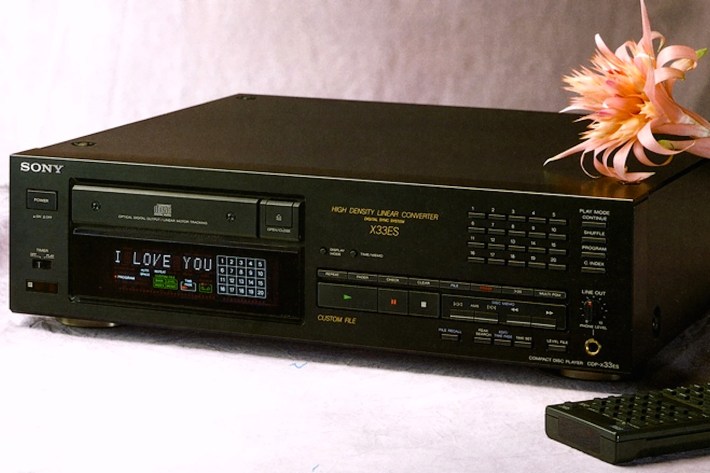 The nineteen nineties would prove to be the decade that Compact Disc truly came of age. Whereas eighties players had usually been eccentric – sometimes even strange – by 1990 the breed was fast becoming refined into what we would recognise today as ‘normal’. The Sony CDP-X33ES was the very personification of this; nowadays it seems totally run of the mill – possibly a little dated, stylistically – and nothing to write home about. However, at the time of its introduction in the first year of the last decade of the twentieth century, it seemed the embodiment of nineties sophistication.
The nineteen nineties would prove to be the decade that Compact Disc truly came of age. Whereas eighties players had usually been eccentric – sometimes even strange – by 1990 the breed was fast becoming refined into what we would recognise today as ‘normal’. The Sony CDP-X33ES was the very personification of this; nowadays it seems totally run of the mill – possibly a little dated, stylistically – and nothing to write home about. However, at the time of its introduction in the first year of the last decade of the twentieth century, it seemed the embodiment of nineties sophistication.
Its star attraction was its Sony CXD2552Q 1-bit DAC. With its embryonic Super Audio Compact Disc format in development, the company was totally committed to Bitstream and this was a testament to it. Lest we forget, this (almost) brand new DAC design was supposed to be less noisy than the 16-bit, 4 times oversampling chips that Sony and its rivals had been running for years – and more importantly, it was a good deal cheaper to mass produce. Bitstream was sold on its audiophile credentials, but the cost issue wasn’t widely discussed at the time. The X33ES was the cheapest in its premium-prices ES range, and sold in the UK for a very competitive £600.
The idea was to give a taste of the high end ES products, but at a more affordable price. It would give almost nothing away in terms of facilities to any of its more expensive brothers; indeed it was better equipped than the £2,000 CDP-X77ES in many ways. It had a direct access track keypad and ‘music calendar’ on its comprehensive, dot-matrix fluorescent display – and lightning fast track access times from its Sony KSS-270A mechanism. The importance of the latter can’t be understated – just a few years earlier it would take up to ten seconds for a first generation Philips machine to crawl its way from one end of the disc to another, yet this could do the same operation in under a second. It made the ‘X33ES feel ultra modern and highly sophisticated to use.
The finish of the machine wasn’t as lavish as its more expensive bigger brothers, but it shared a large metal box (430 x 125 x 375mm) with a beautiful brushed aluminium fascia and black painted pressed steel chassis and case. Weighing 10kg, it wasn’t exactly full of air and most of this weight came down to the solid base and twin power transformers (one for digital, one for analogue). Round the back, you got fixed and variable outputs (the motorised output level potentiometer, controllable from the RM-D590 remote control, was the height of cool, back then) and a digital optical output.
The CDP-X33ES measured superbly by the standards of its day, with a frequency response of 2Hz〜20kHz ±0.3dB, Total Harmonic Distortion of 0.002% (EIAJ), and a signal-to-noise ratio of 113dB (EIAJ). It consumed 18W of power. Sonically, it was distinctively Sony (of that period), which is to say very precise and detailed, with an extremely highly etched sound and seemingly boundless energy. At the time it seemed ultra modern, with so much more focus than your average Philips-based CD spinner of a similar price, yet it’s fair to say it wasn’t the most beguiling and alluring listen. Although very powerful and animated, the Sony lacks subtlety and finesse, with a lively top end that really comes out to say hello. This is balanced by a strong bass however, so the effect is impressive in hi-fi terms, even if it’s not the sweetest and most naturally musical machine around.
Vast quantities of CDP-X33ES players were sold, so they’re not that difficult to find – although the laser isn’t commonly available now so consider this when agreeing a price. Make sure you get to hear the machine working and don’t buy a worn example; there are plenty to choose from. Find a well preserved specimen, pay £150, and you’ll be transported back to the time that Acid House ruled the world, and John Major was Britain’s new hope for the future. A lot has changed since then, obviously…!

The CDP-2700 ‘studio version’ is almost the same unit, sans separate transformer for the logic – inside the transformer is separate anway. The CDP-2700 gives you balanced, ultra hot outputs and AES digital too. Also pitch control which is very, very nice and slick.
The laser is still available aftermarket KSS240A but usually to get a player running the trimmers need slight adjustment. You can do this without a scope too.
Today, on October, 27th, 2019 I don’t find an original pickup Sony replacement KSS 270A or a MSS 271A. Se can tenta to search the original sony diode replacement for KSS 270A or KSS 271A pickups bit it is very hard to find them, perhaps suite impossible! I don’t want Chinese replacements but only original Sony replacements, diodes tools. I’ ve got a X33 ES, it sounds beautiful and works fine, I don’t want to be obliged to leave il!